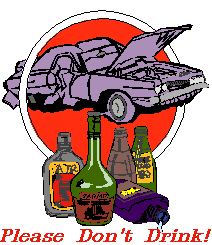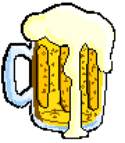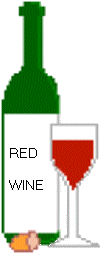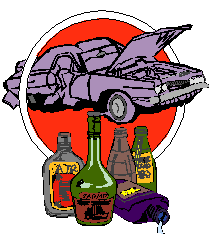Alcohol

Between 1995 and
1996, the percentage of
8th-graders reporting daily
use of alcohol increased from 0.7 percent
to 1.0
percent. In addition, the percentage of 8th-graders
reporting having "been drunk" in the past month
increased from
8.3 percent in 1995 to 9.6 percent in
1996.

Alcohol use among 10th- and 12th-graders remained level but at high rates, with 21.3 percent of
10th-graders and 31.3 percent of 12th-graders
reporting having been drunk in the past month.

Binge
drinking (having five or more drinks in a row
in the
preceding 2 weeks) was reported by 30.4 percent
of high school
seniors, 24.8 percent of
10th-graders, and 15.6 percent of
8th-graders in
1996.

Direct Effects
of Alcohol. Alcohol may encourage
aggression or violence by disrupting normal brain
function.
According to the disinhibition hypothesis,
for example, alcohol
weakens brain mechanisms that
normally restrain impulsive behaviors,
including inappropriate aggression (5). By impairing information
processing, alcohol can also lead a person to misjudge
social cues,
thereby overreacting to a perceived
threat (6). Simultaneously, a
narrowing of attention
may lead to an inaccurate assessment of the
future
risks of acting on an immediate violent impulse (7).

Many researchers have explored the relationship of
alcohol
to aggression using variations of an
experimental approach
developed more than 35 years
ago (8,9). In a typical example,
a subject administers electric shocks or other painful
stimuli
to an unseen "opponent," ostensibly as part
of a competitive task
involving
learning and reaction time. Unknown to the subject,
the reactions of the nonexistent opponent are simulated
by a
computer. Subjects perform both while sober
and after consuming
alcohol. In many studies, subjects exhibited increased
aggressiveness
(e.g., by administering stronger shocks) in
proportion to increasing alcohol consumption (10).

These findings suggest that alcohol may facilitate
aggressive behavior. However, subjects rarely
increased
their aggression unless they felt threatened
or provoked.
Moreover, neither intoxicated nor
sober participants
administered painful stimuli
when non-aggressive means of communication (e.g., a signal lamp) were also available (5,9).

These results
are consistent with the real-world
observation that intoxication alone does not cause violence (4).
The
following subsections explore some mechanisms
whereby
alcohol's direct effects may interact with
other factors to
influence the expression of aggression.

Social and Cultural Expectancies. Alcohol consumption
may
promote aggression because people expect it to
(5). For example,
research using real and mock
alcoholic beverages shows that
people who believe they have consumed alcohol begin to act more
aggressively, regardless of which beverage they
actually
consumed (10). Alcohol-related expectancies
that promote
male aggressiveness, combined with the widespread perception
of intoxicated women as
sexually receptive and less able to
defend
themselves, could account for the association between
drinking and date rape (11).

In
addition, a person who intends to engage in a
violent
act may drink to bolster his or her courage or in hopes of
evading punishment or censure (12,13).
The motive of drinking
to avoid censure is encouraged by the popular view of
intoxication as a "time-out".
(14,15)

Childhood Victimization. A history of childhood sexual
abuse (16) or neglect (17) is more likely among women
with
alcohol problems than among women without alcohol
problems. Wisdom and colleagues (17) found no
relationship between
childhood victimization and
subsequent alcohol misuse in men.
Even children who
only witness family violence may learn to
imitate
the roles of aggressors or victims, setting the stage
for alcohol abuse and violence to persist over generations (18). Finally, obstetric complications that damage the
nervous
system at birth, combined with subsequent
parental neglect such
as might occur in an
alcoholic family, may predispose one to
violence,
crime, and other behavioral problems by age 18
(19,20).

Violent Lifestyles. Violence may precede alcohol
misuse in
offenders as well as victims. For
example, violent people may be
more likely than nonviolent people to select or encounter social
situations and subcultures that encourage heavy
drinking (21). In
summary, violence may contribute
to alcohol consumption, which in
turn may perpetuate violence.

Diagnosis is the process of identifying and
labeling specific
conditions such as alcohol abuse
or dependence (1). Diagnostic
criteria for alcohol
abuse and dependence reflect the consensus
of
researchers as to precisely which patterns of
behavior or
physiological characteristics
constitute symptoms of these
conditions (1).
Diagnostic criteria allow clinicians to plan
treatment
and monitor treatment progress; make communication
possible between clinicians and researchers; enable
public health
planners to ensure the availability of treatment facilities;
help health care insurers
to decide whether treatment will be
reimbursed; and
allow patients access to medical insurance
coverage
(1-3).

Diagnostic criteria for alcohol abuse and dependence
have
evolved over time. As new data become available,
researchers
revise the criteria to improve their
reliability, validity, and
precision (4,5). This Alcohol
Alert traces the evolution of
diagnostic criteria
for alcohol abuse and dependence through the
current standards of the American Psychiatric
Association's
Diagnostic and Statistical Manual of
Mental Disorders, Fourth
Edition (DSM-IV) (6). For
comparison, the criteria found in the
World Health
Organization's International Classification of Diseases,
Tenth Revision (ICD-10)also are reviewed
briefly, although these are
not often used in the
United States (7).

Despite a minimum legal drinking
age of 21, many young people
in the United States
consume alcohol. Some abuse alcohol by
drinking frequently or by binge drinking--often defined as
having five or more drinks* in a row. A minority of
youth may
meet the Diagnostic and Statistical Manual
of Mental Disorders,
Fourth Edition (DSM-IV) criteria
for alcohol dependence (1,2).
The progression of
drinking from use to abuse to dependence is
associated with biological and psychosocial factors.
This
Alcohol Alert examines some of these factors
that put youth at risk
for drinking and for
alcohol-related problems and considers some of
the
consequences of their drinking.

Thirteen- to fifteen-year-olds are at high risk to
begin
drinking (3). According to results of an
annual survey of students
in 8th, 10th, and 12th
grades, 26 percent of 8th graders, 40
percent of
10th graders, and 51 percent of 12th graders
reported
drinking alcohol within the past month (4).
Binge drinking at
least once during the 2 weeks before the survey was reported by
16 percent of 8th graders,
25 percent of 10th graders, and 30
percent of 12th
graders.

Males report higher rates of daily drinking and binge
drinking than females, but these differences are diminishing (3).
White students report the highest
levels of drinking, blacks
report the lowest, and Hispanics fall between the two (3).

A survey focusing on the alcohol-related problems
experienced by 4,390 high school seniors and dropouts
found that
within the preceding year, approximately 80
percent reported
either getting "drunk," binge drinking, or
drinking and driving. More
than half said that drinking
had caused them to feel sick, miss
school or work,
get arrested, or have a car crash (5).

Some
adolescents who drink later abuse alcohol and may
develop alcoholism. Although these conditions are
defined for
adults in the DSM, research suggests
that separate diagnostic
criteria may be needed for
youth (6).

Genetic Risk Factors. Animal studies (14) and
studies of
twins and adoptees demonstrate that
genetic factors influence an
individual's vulnerability to alcoholism (15,16). Children of
alcoholics are significantly more likely than
children of non-alcoholics to initiate drinking
during adolescence (17) and to
develop alcoholism (18),
but the relative influences of
environment and genetics
have not been determined and vary among
people.

Biological Markers. Brain waves elicited in response to
specific stimuli (e.g., a light or sound) provide
measures of
brain activity that predict risk for
alcoholism. P300, a wave
that occurs about 300
milliseconds after a stimulus, is most
frequently
used in this research. A low P300 amplitude has
been demonstrated in individuals with increased risk
for alcoholism, especially sons of alcoholic fathers
(19,20). P300
measures among 36 preadolescent boys
were able to predict alcohol
and other drug (AOD) use 4 years later, at an average age of 16
(21).

Childhood
Behavior. Children classified as "under-controlled"
(i.e., impulsive, restless, and distractible) at
age 3 were twice as
likely as those
who were "inhibited" or "well-adjusted" to be
diagnosed
with alcohol dependence at age 21 (22). Aggressiveness
in children as young as ages 5-10 has been found to
predict AOD
use in adolescence (23,24). Childhood
antisocial behavior is
associated with alcohol-related
problems in adolescence (24-27)
and alcohol abuse or dependence in adulthood (28,29).

Six-year-old to seventeen-year-old boys with attention
deficit hyperactivity disorder (ADHD) who were also found
to have
weak social relationships had significantly
higher rates of
alcohol abuse and dependence 4 years later,
compared with ADHD
boys without social deficiencies and
boys without ADHD (32).

Whether anxiety and depression lead to or are
consequences
of alcohol abuse is unresolved. In a
study of college freshmen, a
DSM-III (33) diagnosis
of alcohol abuse or dependence was twice as
likely
among those with anxiety disorder as those without
this
disorder (34). In another study, college
students diagnosed with
alcohol abuse were almost
four times as likely as students without
alcohol
abuse to have a major depressive disorder (35). In most
of
these cases, depression preceded alcohol abuse.
In a study of
adolescents in residential treatment
for AOD dependence, 25 percent
met the DSM-III-R criteria for depression, three times the rate
reported for controls. In 43 percent of these cases, the
onset of AOD
dependence preceded the depression; in
35 percent, the depression
occurred first; and in 22 percent,
the disorders occurred
simultaneously (36).

Suicidal Behavior.
Alcohol use among adolescents has been
associated with considering, planning, attempting, and completing
suicide
(37-39). In one study, 37 percent of eighth-grade
females who drank heavily reported attempting
suicide, compared
with 11 percent who did not drink
(40). Research does not
indicate whether drinking
causes suicidal behavior, only that the
two
behaviors are correlated.

Parenting, Family Environment, and Peers. Parents'
drinking
behavior and favorable attitudes about
drinking have been positively
associated with
adolescents' initiating and continuing drinking
(41,42). Early initiation of drinking has been
identified as an
important risk factor for later
alcohol-related problems (43).
Children who were
warned about alcohol by their parents and
children
who reported being closer to their parents were
less
likely to start drinking (42,44,45).

| DARE | Alcohol |
| Cocaine |
Inhalants |
| LSD |
Methamphetamine |
|
PCP |
Marijuana |
|
Heroin |
| Home |
| Michele |
Links |
Sign Language |
| Adoptions |
Animals
| Say No To Drugs |
| Holidays | History |
|
All graphics and
pages are copyright © 1997 - 2008 Pages 4 Ever
(except where noted). Do not take, copy, steal, plagiarize or use in any
way, shape or format without the express written permission of Pages
4 Ever.
Some backgrounds and graphics made from clipart acquired from ArtToday, Boxed Art,
friends, my own imagination, and/or
graphic CD collections that I have purchased. If you find anything on this site
that you have copyright to, and can prove it, please let me know and I will
gladly either remove it or place a link back to you, whichever you prefer.
If you should find any broken links, please drop us a line and let us know the
exact URL the broken link is on. Thank you.
|
|